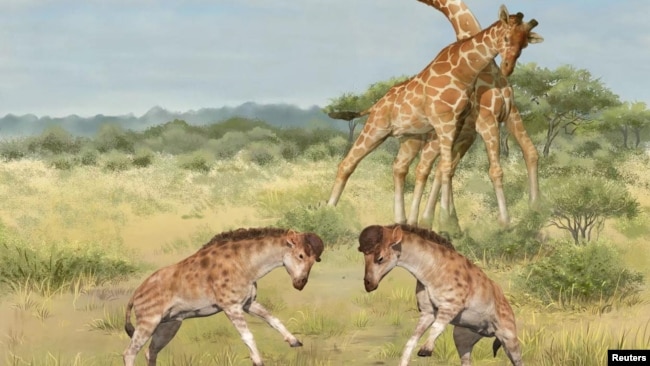古代の骨が語る、キリンの長い首の謎
そうねんですよね!! 私にとっても”謎”でした。
それが、ついに解明されたのか?!
タイトルだけで引き寄せられたこの記事、早速聴いてみましょう!!
皆さんも気になりますよね😄!!
VOAで英語を学びましょう!!♬
科学者見解:古代のキリンの仲間、長い首は戦うために発達(和訳)
Scientists: Ancient Giraffe Family Developed Long Neck for Fighting
June 13,2022
日付のないイラスト、キリン科の動物が繰り広げる雄の競演。手前に見えるのは絶滅種「Discokeryx xiezhi」のオス2頭。(Wang Yu and Guo Xiaocong/Handout via REUTERS)
現代のキリンの遠い祖先の古代骨が、なぜキリンの長い首が発達したのかについて科学者に証拠を提供しています。
科学者によれば、中国で発見されたこれらの化石は、長い首が雄同士の競争に役立っていたことを示唆しているとのことです。
研究者たちは最近、厚い頭蓋骨、または頭の骨、および強力な首の骨を含む化石を解説しました。この化石は、Discokeryx xiezhi(ディスコケリクス・シエジー)と呼ばれるキリン科の初期のメンバーのものです。この生物は、約1700万年前に中国北西部のシンジャン(新疆ウイグル自治区)に生息していました。
※Xinjiang :[ʃinˈdʒjɑŋ]新疆ウイグル自治区
ディスコケリクスの頑丈に作られた頭蓋骨と強い首の骨が、高速での正面衝突によく適応していたのです。研究者らは、これらは哺乳類のオスの間で見られる、メスの相手をめぐる競争のようなものであと言います。
彼らは、ディスコケリクスは哺乳類の中で最も複雑な首の骨を持っていると説明しています。これは、頭と首の間の関節だけでなく、個々の首の骨の間の関節も同様です。
Discokeryx (ディスコケリクス)は”円盤状の角”を意味し、xiezhi(シエジー)は中国の伝統的な物語に登場する一本角の生物です。ディスコケリクスの頭蓋骨には、オシコンと呼ばれる大きな丸い形と厚みのある骨の構造がありました。これはキリンの頭頂部にある角のようなものの名称です。
Scienceサイエンス誌に発表されたこの研究の主執筆者であるシー・チー・ワン氏は、「オシコーンは、角やツノのように、通常オスが交尾のために戦うための武器として機能します 。」と述べています。
Scienceサイエンス誌⬇️
https://www.science.org/doi/10.1126/science.abl8316

Credit: SHI-QI WANG et al., Science(2022)
研究の共同執筆者のジン・メン氏は、現代のキリンがなぜそのような長い首を持っているかについての従来の考え方は、長い首が木の葉を食べるのに便利だからだと言っています。「ディスコケリクスは草を食べていた可能性が高いのです。」とメン氏は説明しています。
さらに、「この新しい発見は、キリンの仲間では、進化の初期にさまざまなことをすることを示しています。新種は、強力な頭突きによる力と衝撃を吸収するために、首が...非常に太くなった極端な例を示しています 。」と付け加えます。
キリンの首の進化に関するもう一つの考え方は− ディスコケリクスの骨構造によって裏付けられたものですが− 首の長さは、現在のキリンに見られる”ネッキング”のような交尾の競争で示される行動によって駆動されたというものです。このような競争では、雄は互いの首で激しく打ち合う。首の長いオスが勝つことが多いのです。
「もし、キリンの雄の首が短いと、雌はその雄の交尾の要求を拒否することができるのです。」とワン氏は言います。
首が長くなること、伸びることは、数億年前にいくつかの動物群の間で独自に進化しました。
研究者らは、ディスコケリクスは、数百万年かけて行われたキリンの首の長大化の初期の発展についての情報を提供してくれるかもしれないと述べています。
しかし、ディスコケリクスは頭突き用に特化した別の進化の道を歩んでいます。現在のキリンの直接の祖先ではなく、むしろキリン科の副次的な発展であると考えられています。
サハラ砂漠以南のアフリカに生息する現代のキリンは、現存する陸上動物としては世界で最も体高の高い動物です。オスは5.5m、メスは4.3mまで成長することができます。キリンの首は約1.8メートルもあり、他の哺乳類と同じように7本の首の骨があるだけです。
ディスコケリクスは、中新世と呼ばれる時代に小さな樹木群のある開けた草原に生息していました。古代のゾウ、サイ、ブタ、シカ、ウマなどと一緒に暮らしていました。当時の捕食者は、サーベル・トゥース・キャット(剣歯猫)、ハイエナ、そして”イヌグマ”と呼ばれる哺乳類グループの一員で、現代の白熊と同じくらいの大きさの生物でした。
Scientists: Ancient Giraffe Family Developed Long Neck for Fighting
The ancient bones of a distant ancestor of the modern giraffe are offering scientists evidence about why the animal’s long neck developed.
Scientists say these fossils, which were discovered in China, suggest a long neck was helpful for competitions between males.
Researchers recently described the fossils including a thick skull, or bones of the head, and strong neck bones. They belonged to an early member of the giraffe family called Discokeryx xiezhi. The creature lived about 17 million years ago in the Xinjiang area in northwestern China.
Discokeryx's solidly-built skull and strong neck bones were well adapted to high-speed head-to-head crashes. They were like competitions seen among males of some mammal species for female mates, the researchers said.
They explained that Discokeryx had the most complex neck bones of any mammal. This was the case for joints between the head and neck as well as between the individual neck bones.
Discokeryx means "disc-horn," while xiezhi is a single-horned creature in traditional Chinese stories. Discokeryx's skull had a large round-shaped and thick bone structure known as ossicone. That is the name for the horn-like objects on the top of giraffe's heads.
Shi-Qi Wang Wang , lead writer of the study published in Science, said, "Ossicones, like horns and antlers, usually serve as weapons for males fighting for mates."
Study co-writer Jin Meng said the traditional idea about why modern giraffes have such long necks is that long necks are useful for eating tree leaves. "Discokeryx most likely ate grasses," Meng explained.
Meng added, "This new finding shows that, in the giraffe family, members do different things in their early evolution. The new species represents an extreme example in which the neck ... becomes very thick to absorb the power and impact from powerful head-butting."
Another idea about giraffe neck evolution - one supported by Discokeryx's bone structure - is that neck lengthening was driven by behavior shown in competition for mates like the "necking" seen in giraffes today. In such competitions, males violently strike each other with their necks. Longer-necked males often win these fights.
"If a male giraffe has a shorter neck, then the female may refuse the mating request of the male," Wang said.
Neck lengthening, or elongation, independently evolved among several animal groups hundreds of millions of years ago.
Discokeryx, the researchers said, may offer information about the early developments of giraffe neck lengthening that took place over millions of years.
Discokeryx, however, took a different evolutionary path specialized for head-butting. It is not considered a direct ancestor of today's giraffe, but rather a side development of the giraffe family.
The modern giraffe, found in Africa south of the Sahara Desert, is the world's tallest living land animal. Males can grow up to 5.5 meters tall and females up to 4.3 meters tall. A giraffe's neck, stretching about 1.8 meters, has just seven neck bones like other mammals.
Discokeryx lived in open grasslands with small groups of trees during a time known as the Miocene period. It lived alongside ancient elephants, rhinos, pigs, deer, and horses. Predators at the time included saber-toothed cats, hyenas and a member of a mammalian group called "dog bears" - a creature as big as a modern polar bear.
Words in This Story
giraffe – n. a very tall African animal that has an extremely long neck and legs
fossil – n. something (such as a leaf, skeleton, or footprint) that is from a plant or animal which lived in ancient times and that you can see in some rocks
evolution – n. the process by which changes in plants and animals happen over time
adapt—v. to change (something) so that it functions better or is better suited for a purpose
impact – n. the act or force of one thing hitting another
predator – n. an animal that lives by killing and eating other animals : an animal that preys on other animals
Giraffe 'Necking' キリンのネッキング
